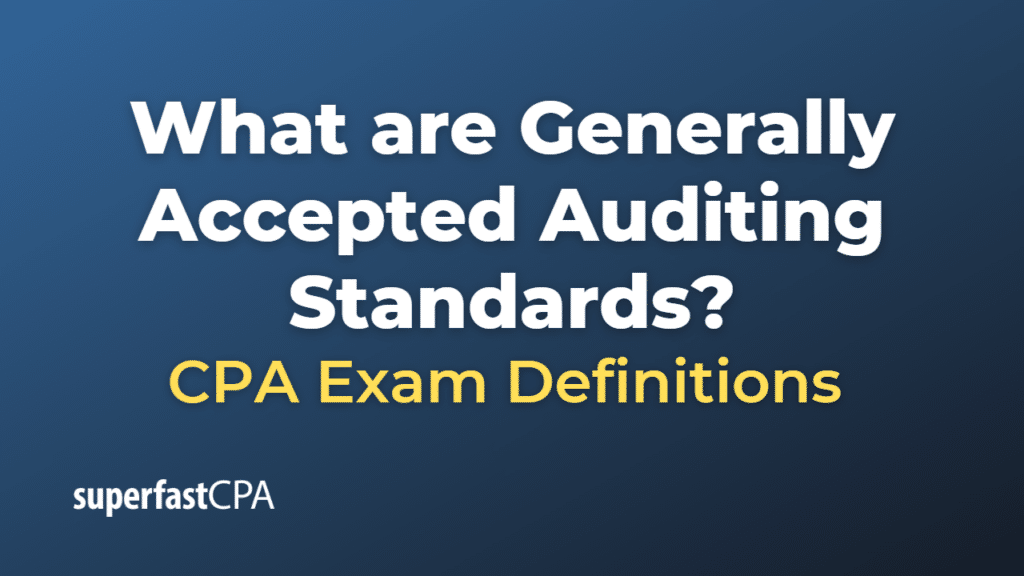Generally Accepted Auditing Standards
Generally Accepted Auditing Standards (GAAS) are a set of systematic guidelines used by auditors when conducting audits on companies’ financial records. GAAS helps to ensure the accuracy, consistency, and verifiability of auditors’ actions and reports.
The standards were originally developed by the American Institute of Certified Public Accountants (AICPA) and have been codified into the Statement of Auditing Standards (SAS).
GAAS are organized into three categories:
- General Standards: These pertain to the personal qualifications of the auditor and the quality of the auditor’s work. They are:
- The audit must be performed by a person or persons having adequate technical training and proficiency as an auditor.
- The auditor must maintain independence (in mental attitude) in all matters relating to the audit.
- The auditor must exercise due professional care during the performance of the audit and the preparation of the report.
- Standards of Field Work: These relate to the auditor’s own work conduct and the methods used to gather and process evidence during the audit. They are:
- The auditor must adequately plan the work and must properly supervise any assistants.
- The auditor must obtain a sufficient understanding of the entity and its environment, including its internal control, to assess the risk of material misstatement of the financial statements whether due to error or fraud, and to design the nature, timing, and extent of further audit procedures.
- The auditor must obtain sufficient appropriate audit evidence by performing audit procedures to afford a reasonable basis for an opinion regarding the financial statements under audit.
- Standards of Reporting: These pertain to what the auditor says in the audit report. They are:
- The auditor must state in the auditor’s report whether the financial statements are presented in accordance with generally accepted accounting principles (GAAP).
- The auditor must identify in the auditor’s report those circumstances in which such principles have not been consistently observed in the current period in relation to the preceding period.
- When the auditor determines that informative disclosures are not reasonably adequate, the auditor must so state in the auditor’s report.
- The auditor must either express an opinion regarding the financial statements, taken as a whole, or state that an opinion cannot be expressed, in the auditor’s report. When the auditor cannot express an overall opinion, the auditor should identify those items that preclude the auditor from doing so.
Please note, in the United States, auditing standards have largely transitioned to the Public Company Accounting Oversight Board (PCAOB) for public companies, and the Auditing Standards Board (ASB) of the AICPA for non-public companies. Internationally, the International Standards on Auditing (ISAs) issued by the International Auditing and Assurance Standards Board (IAASB) are followed.
Example of Generally Accepted Auditing Standards
Let’s look at a hypothetical example to illustrate how Generally Accepted Auditing Standards (GAAS) are used:
Assume ABC company is being audited by XYZ auditing firm.
General Standards
- The auditors from XYZ are certified public accountants (CPAs), having passed the required examinations and possessing the necessary experience to conduct the audit. This ensures they have the “adequate technical training and proficiency.”
- The auditors have no financial or personal ties to ABC company, ensuring their “independence” in the audit.
- The auditors are diligent in carrying out their responsibilities and follow the necessary ethical guidelines, ensuring they “exercise due professional care.”
Standards of Field Work
- The auditors develop a detailed plan for the audit, and any assistants involved in the process are properly supervised.
- The auditors gain an understanding of ABC’s business operations, the business environment, and ABC’s internal control systems to assess the risk of material misstatements in the financial statements.
- The auditors gather evidence by examining ABC’s financial records, observing physical inventory counts, and confirming account balances with third parties, ensuring they have “sufficient appropriate audit evidence.
Standards of Reporting
- In their audit report, the auditors state that ABC’s financial statements are presented in accordance with GAAP.
- They identify that ABC’s method for recognizing revenue has been consistently applied in the current period and the preceding period.
- The auditors evaluate the disclosures made by ABC in its financial statements and find them to be adequate and informative.
- The auditors conclude, based on their audit, that ABC’s financial statements present fairly, in all material respects, the financial position, results of operations, and cash flows of ABC in conformity with GAAP. They express this opinion in their audit report.
Remember, this is a simplified example. Actual audits are usually far more complex and detailed, and they involve numerous other procedures not mentioned here.













